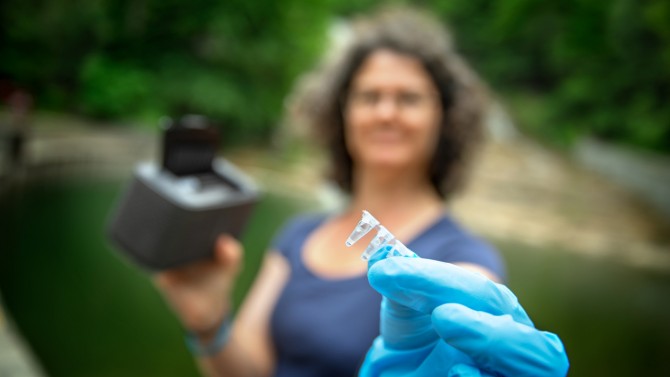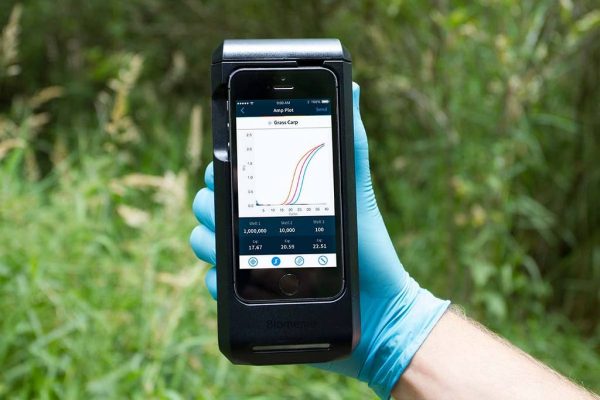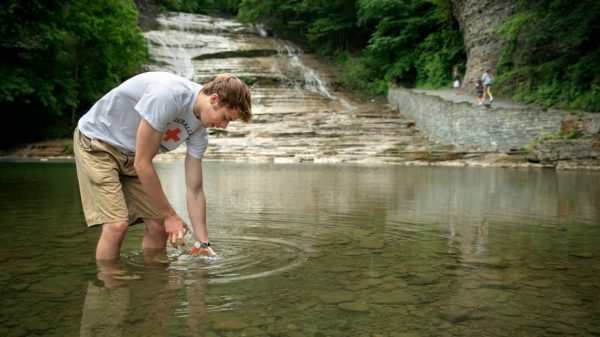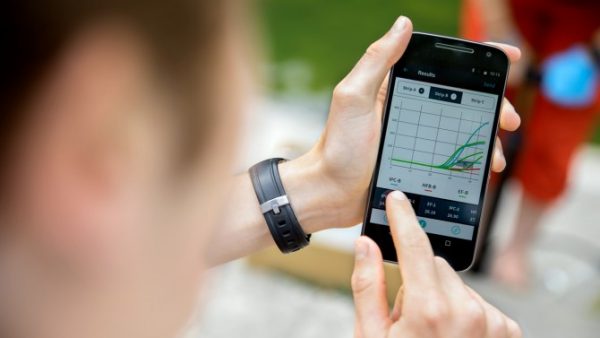eDNA Tests Swimmability in 90 Minutes or Less

Ruth Richardson, associate professor of civil and environmental engineering, holds water samples to be inserted into the Biomeme device. (Credit: Lindsay France/Cornell University Photography, http://news.cornell.edu/stories/2018/07/engineers-test-device-monitoring-ny-state-park-water-quality.)
In most places around the country where freshwater lakes and beaches offer recreational opportunities, health officials monitor the water for elevated bacterial counts—usually about once a week in populated areas, less often in more remote locations. However, the current state-of-the-art testing leaves about 24 to 30 hours of lag time between when water is tested for bacteria and when results come back. During that time, if the water seems unsafe, officials usually limit access to it.
This summer, researchers from Cornell University were testing a new approach using environmental DNA (eDNA) with the help of Biomeme Inc., a biotechnology device company. Led by associate professor of civil and environmental engineering Ruth Richardson, the team tested Biomeme’s two3™ DNA detector, to determine if it might be used by officials at state park swim beaches as a rapid water-testing device.
Professor Richardson filled EM in on the tests and the device.
Using eDNA at the beach
Biomeme’s two3™ DNA detector is a variety of Quantitative PCR (qPCR) thermocycler—not entirely unlike the PCR thermocyclers used by forensic scientists, but with some important differences.
“The main difference from the benchtop thermocyclers to our two3™ is that the two3™ is very small (about the size of a pint glass), portable, and battery driven,” explains Dr. Richardson. “This allows the user to perform lab quality DNA analysis in the field and at the point of need.”
The device detects fecal indicator bacteria, which can indicate that a range of pathogens may be in the water. Richardson and the team are focusing on pathogens that impact the gastrointestinal tract—a common cause of illness among swimmers. In most cases, they get results less than one hour after sampling the water using just the device and a smartphone.

The two3™ Real-Time PCR Thermocycler. (Credit: Biomeme, Inc., https://shop.biomeme.com/collections/devices/products/two3-real-time-pcr-thermocycler?variant=656490790924.)
“The two3™ is a two-color (FAM and Cy5), three-well PCR thermocycler that performs equivalently to gold standard benchtop thermocyclers,” details Dr. Richardson. “It integrates with an iPhone using the built-in camera for detection and is driven from an app on the phone. The two3™ weighs 1.1lbs and is 7 X 3 X 3 inches. There are no moving parts aside from the cooling fan. The battery life allows for 6-8 full-length PCR runs before needing charging via the built-in AC/DC wall adaptor.”
The team traveled to various locations to test, and each time the device sent its data to a cloud portal. However, even in remote locations, connectivity hasn’t been an issue.
“The device can upload data via cellular or WiFi networks, so the ability to upload data covers a really broad area,” clarifies Dr. Richardson. “However, if the user can’t get access to the internet it isn’t a problem. The device stores information locally as well. This means that any data can be uploaded once the user is able to connect to the internet. In short, the device will work both on and off the grid.”
Dr. Richardson and the team ran tests alongside the standard testing at beaches all summer, and the device was reliable.

Nate Barott, a member of Ruth Richardson’s research team, collects a water sample in June at Buttermilk Falls State Park in Ithaca. The sample was tested using the Biomeme two3 smartphone-enabled PCR thermocycler device. (Credit: Lindsay France/Cornell University Photography, http://news.cornell.edu/stories/2018/07/engineers-test-device-monitoring-ny-state-park-water-quality.)
“Comparisons have been made to two current EPA certified methods—the culture based Enterolert and the qPCR based EPA1611.1,” states Dr. Richardson. “There was a 90% correlation between quantities from qPCR on the Biomeme two3™ and using the EPA 1611 method. Additionally, both qPCR methods did equally well in correlating with Enterolert values and had 87.5% accuracy in “calling” whether the beach action value threshold was exceeded based on Enterolert values.”
Putting new technologies to work
Biomeme’s device wasn’t designed for swim water testing, although that is an intuitive application for the tool.
“The two3™ was not designed for any particular use case, but rather for a wide range of applications, water testing being one of them,” remarks Dr. Richardson. “The goal is to democratize qPCR, so the system is open and designed from the ground up to be mobile. The platform was designed to provide the same flexibility as lab-bound qPCR thermocyclers. It is very adaptable. It’s not just the thermocycler—it’s a whole system. So there is sample preparation (nucleic acid extraction), a thermocycler, field ready PCR chemistry, and software in the form of the mobile app and the cloud portal.”
The idea for adapting the device for swim water testing came as a natural extension of the team’s other plans for it.

Nate Barott checks data collected from the device. (Credit: Lindsay France/Cornell University Photography, http://news.cornell.edu/stories/2018/07/engineers-test-device-monitoring-ny-state-park-water-quality)
“For some international development work we were interested in a rapid field-appropriate test for fecal contamination of drinking water in low resource countries, for example, in rural Africa, where there is limited access to centralized labs with the ability to culture fecal indicator bacteria,” Dr. Richardson describes. “The Biomeme device is both rapid and field-deployable, so my lab was interested in applying it to drinking water monitoring. Since swimming beaches also assess water quality with FIB tests the tool would also be valuable in the US for swimming water monitoring.”
Of course, there are likely to be numerous other possible applications for the device—and Dr. Richardson and the team are thinking about them already.
“In the future, we think that this technology will be used for a number of applications: fighting food fraud, supply chain verification, environmental monitoring of soil and air in addition to water, veterinary applications, and human health—most especially in low resources settings like doctors without borders,” comments Dr. Richardson. “Testing for DNA/RNA is useful in so many different cases. We think that fast onsite qPCR will be a game changer for a number of organizations.”
To learn more about eDNA and how Biomeme harnesses it, Dr. Richardson refers readers to an
eDNA guide. Biomeme’s next-generation device, the three9™, has nine wells, three color channels, and can be run via Bluetooth using an Android or iOS device—and it’s now on the market.
Top image: Ruth Richardson, associate professor of civil and environmental engineering, holds water samples to be inserted into the Biomeme device. (Credit: Lindsay France/Cornell University Photography, http://news.cornell.edu/stories/2018/07/engineers-test-device-monitoring-ny-state-park-water-quality)




0 comments